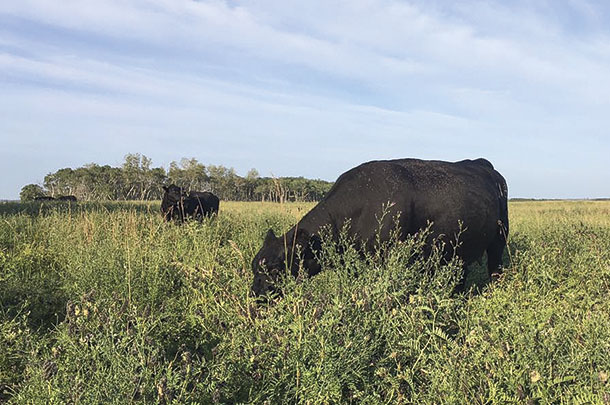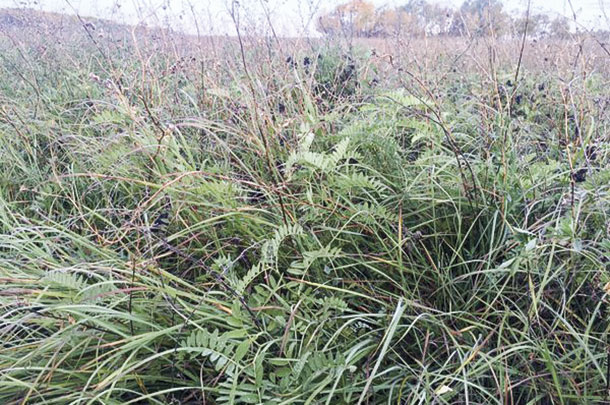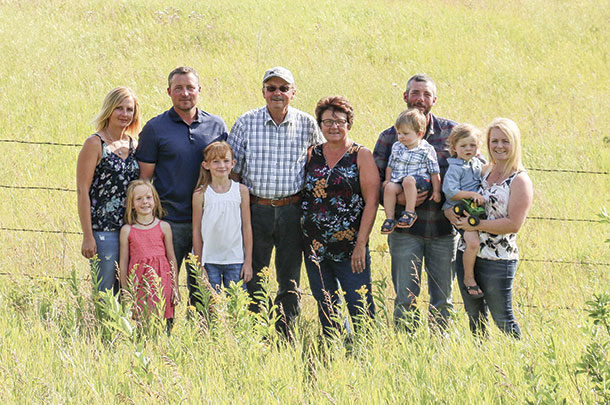Arron and Shane Nerbas make up the third generation of the 5,000-acre ranch near Shellmouth, Manitoba. Arron and Shane returned to the family operation in the early 2000s, joining parents Gene and Cynthia Nerbas, who still have active roles in the operation.
The Nerbases run 600 cow-calf pairs over roughly 5,000 acres of range and pastureland.
Due to various drainage issues in the surrounding area and what Arron Nerbas terms a “general wet cycle in the past 10 years,” most of the family’s prime hay and forage ground was repeatedly flooded, spurring them to find a solution.
“The flooding was the catalyst to us trying to find some alternate ways to do things,” Arron says. “We had to get more production out of our prairie grasslands and, at the same time, we looked into a more organic base for our cattle herd with lower input involved.” They got started by experimenting with rotational grazing, practicing rest/recovery on their land and taking a more holistic approach to their forage management program.
Holistic management
The Nerbases started their holistic management efforts a little over 10 years ago when the Canadian cattle industry was going through a rough period. They were looking to save money and do more with their existing resources, including getting more value from their flooded hay land.
Arron says the commitment to a holistic management style was a family priority. The entire family enrolled in a five-day course and attended several workshops to learn more about holistic management. “We weren’t completely unholistic before we took the course,” he says.
“There were a lot of things we did that fit that model to begin with, but it was a way of understanding full holistic management and then tweaking our system to what we needed.”
They were not alone during their foray into holistic management. Arron says there was a holistic management “club” after the course where the members held meetings and discussions on the challenges and benefits they were dealing with on their individual operations. “It was kind of like a support group but also helped us learn from each other as well,” he says.
Grazing strategies
Arron says rotational grazing and an ample rest and recovery period has been the most effective change they’ve made to their grazing system. “We think we have doubled our grass production compared to what we had prior to rotational grazing, so in a way, that’s like free grass,” he says. “We are trying to get as much out of the land as we can, and our land has responded really well to a planned rotational grazing system.”
They have also expanded their grazing window, turning the cows out in April on stockpiled pastures and keeping them out until November. “We want to graze as early as we can and as late as we can,” Arron says.
“For winter feed, we want to give the least amount we can get away with because anything that’s mechanically made and then fed to the cattle, like hay, is not as efficient as the cow grazing it herself.”

The Nerbases include both native grasses and introduced species in their grazing system: native wheat grasses, bluestem and blue grama grasses, bromegrass, meadow brome, timothy and crested wheatgrass.
They’ve also added legumes like alfalfa, cicer milkvetch, clover and sanfoin to their pastures to add even more diversity to their forage mix and aid in nitrogen fixation in the soil. This diversity not only provides nutrients for the cows but improves the quality of the soil as well.
Pod grazing
During the winter, the Nerbases use a system they call “pod grazing.” They lay out a grid of paddocks with temporary fencing within a bigger permanently fenced pasture and fill each paddock with hay bales. They keep the cattle in one partition at a time until they have finished off the bales.
They have finessed this system to five three-week pods they use up over the course of the winter.
Arron says there are several different benefits to using the pod grazing system. Since a lot of their hay land is frequently flooded, they have let it return to native grasses and purchase most of their hay from outside sources.

One of the most fundamental benefits is the organic matter that builds up after the cattle spend a few weeks in the paddock, which adds to the nutrient content and variety in the soil. “When you buy your feed, you are importing a bunch of nutrients, so we’re getting nutrients that aren’t part of our farm,” he says. “It’s a really beneficial form of fertilizer for us.”
Arron says pod grazing also reduces competition among cows, since every animal in the herd has equal access to feed. It also cuts down on labor. “We don’t even start a tractor for those cows during the winter,” he says. “All we have to do is check them once a day and check the water system and salt minerals. It takes less than half-an-hour to feed 600 cows. We save on labor, machinery, fuel, depreciation, maintenance – all of it.”
Benefits to the herd
The cows start calving in late April and calves are weaned in December. Arron says the timing makes a big difference. “For us, it’s easier to calve in more of a natural setting on the range and more in synch with nature,” he says.
“It’s when the grass starts greening up, and you’ve got access to good grass versus calving in a confined feedlot, and having to supplement them a fair bit because of their nutrition needs when the calf is on them.” He says they struggle less with calving and mothering issues and sickness in both the calves and the cows thanks to their late-spring calving schedule. “I think when we calve that late in the year, everyone’s happier,” he says, “us, the cows, everybody.”
The Nerbases have also changed their herd genetics to reflect their management system. They started out developing stock that would thrive in their low-input forage management system specifically for use in their own herd but have since developed a small seedstock herd, out of which they sell livestock designed to be feed-efficient on a low-input forage system.
More changes
Adam Kerkowich, Lake of the Prairies Conservation District manager, has worked with the Nerbas family for several years as part of a grassroots program that has helped provide resources for different projects on the Nerbas ranch, including assisting with developing their forage management system, installing alternate watering systems and investing in solar power sources.
The Nerbases’ exploratory forage practices have caught the attention of other people in the industry. They’ve even hosted a field day tour on their farm. “A lot of people were just blown away, because the quality of soil that they were doing it on was pretty low-grade stuff, but the forage base itself is very lush, green and thick with deep roots,” he says.
“The practices they are putting forth right now are something that people knew about in the past but didn’t really think would work as well as they are making it work.”
Arron says they don’t have any other major issues on the horizon they need to focus on. “It’s just a matter of improving everything a little bit at a time now,” he says. “We’re always just looking to get better.” ![]()
PHOTO 1: Left to right: Amber, Arron, Gene, Cynthia, Shane, Sacha. Front: Hailey, Emerson, Kane, Cash.
PHOTO 2: Cattle graze mixed forages in one of the pastures at Nerbas Bros. Angus.
PHOTO 3: A forage mix including cicer milkvetch, alfalfa, meadow brome and some native grasses. Photos provided by Arron Nerbas.

-
Carrie Veselka
- Associate Editor
- Progressive Forage
- Email Carrie Veselka













